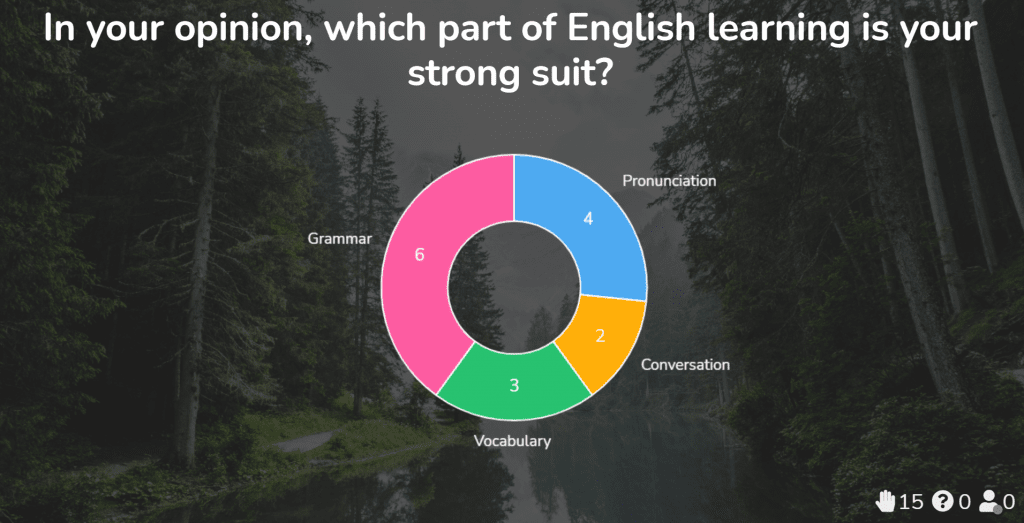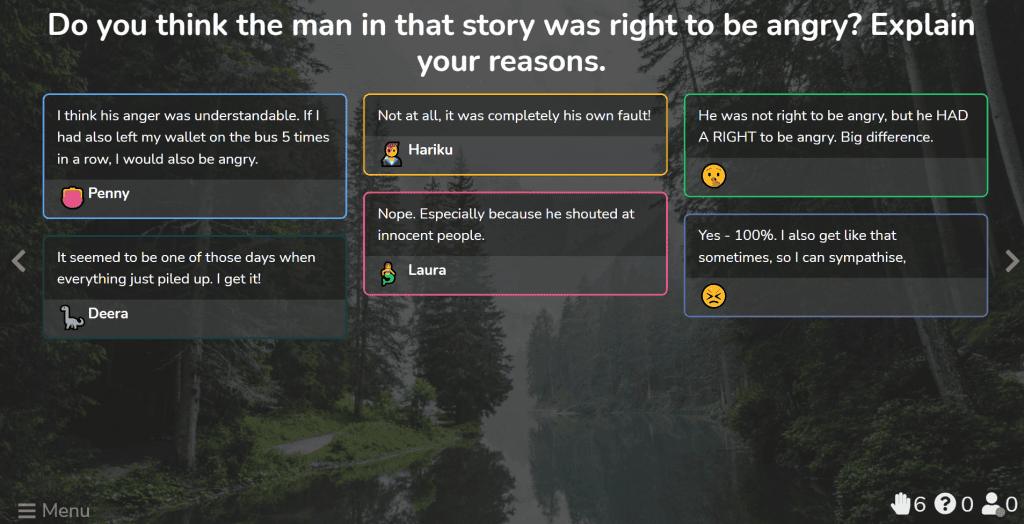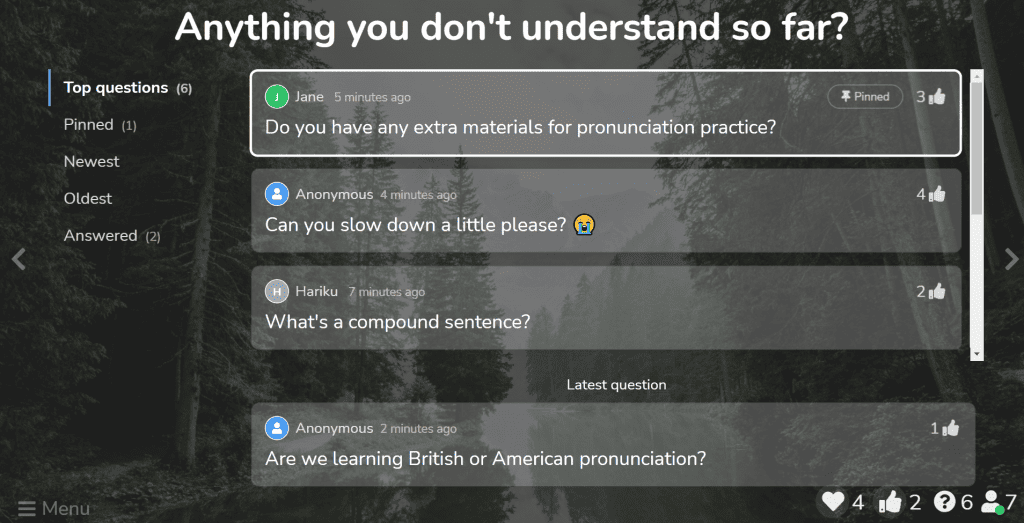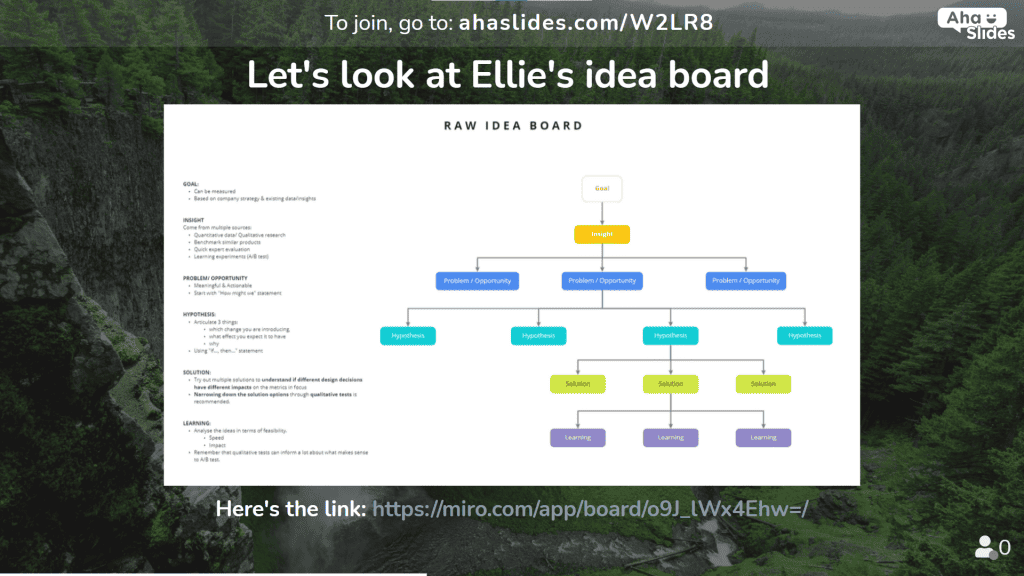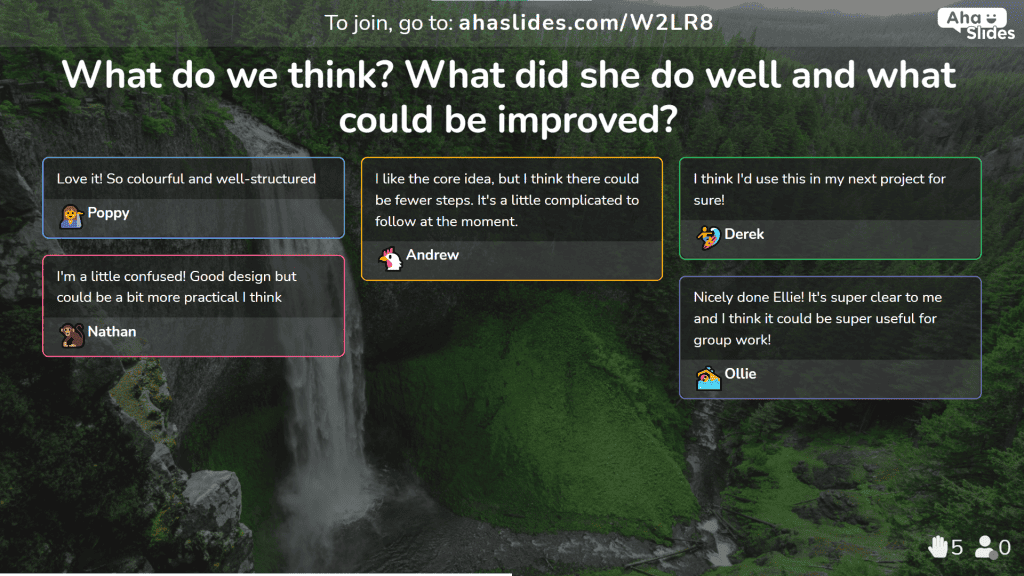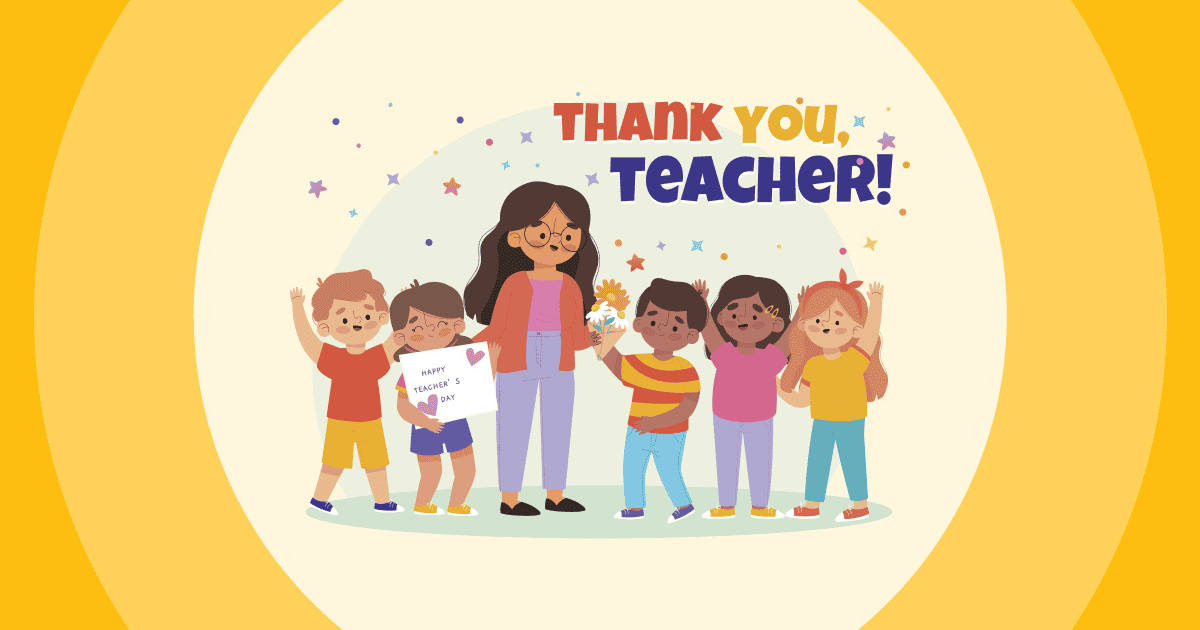我們常聽到這樣一句話:優秀的老師是優秀的激勵者。這個道理很簡單,但它卻是基於教育工作者幾十年來一直在努力探討的一個概念: 我如何激勵我的學生?
嗯,動力不足會滋長動力不足。如果你不能激勵你的學生, 你如何激勵自己去教他們?
這是一個惡性循環,但以下 12 個建議可以幫助 學生課堂參與 在一系列 互動課堂活動 下面的內容可以幫助您阻止腐爛。
如何提升學生課堂參與度-指南
- 為什麼學生課堂參與很重要?
- #1 – 參考學生意見
- #2 – 讓他們說話
- #3 – 品種競賽與測驗
- #4 – 設定問答檢查點
- #5 – 讓他們教
- #6 – 混合你的風格
- 7. 使其相關
- #8 – 給他們一個選擇
- 9.擁抱科技
- #10 – 翻轉劇本
- #11 – 參觀畫廊
- #12 – 永遠不要放棄小組工作
更多課堂管理技巧,盡在 AhaSlides
為什麼學生課堂參與很重要?
人們很容易認為學習不投入的學生是無法挽救的,甚至認為「學生參與」只是那些時間充裕的老師才會考慮的概念。但透過深入探討這個主題,你展現出了激勵學生的動力。這才是真正的激勵!
您已經朝著提高學生學習水平邁出了正確的一步。如果您是正在尋求作業幫助的學生,不妨考慮向最優秀的 文章 寫作服務。這些服務可以為磨練您的寫作技巧並確保您的學術努力成功提供寶貴的支援。
- 53% 的美國學生是 不恩加GED or 主動脫離 在課程中。 (蓋洛普)
- 到 2020 學年末,已有 1.3 萬學生停止參與 因為轉向遠程學習。 (提醒)
- 參與的學生得出結論的可能性要高出 2.5 倍 在校成績優異。 (蓋洛普)
學習脫離就像一種流行病,但總有辦法阻止它。以下技巧將幫助你重新點燃學生與生俱來的學習好奇心,無論線上或線下,使用 在線學習學生參與 技術。
4 輕鬆獲勝
下面的四種技術是 最快 最簡單的 吸引學生興趣的方法。這些方法設定起來非常簡單,而且各個層級的學生都能輕鬆理解。
#1 – 參考學生意見
民意調查具有決定性作用,因為民意調查將你的主題與任何年輕人的世界中心——他們自己——聯繫起來。
我孩子,當然。 還是讓他們 發表他們的意見 對某事,看看他們的意見如何適應周圍的系統, 可以創造奇蹟 以備學生注意。
在您的課程中給予他們參與的聲音有很多好處,但最重要的是讓學生知道 意見,不是 主題,是這裡節目的真正明星。
看看下面的這個問題,可以在 ESL 課程中提出。
這項民意調查非常適合參與,因為:
- 問題是關於 他們.
- 學生可以立即看到他們的意見 與他人疊加 在他們旁邊。
- 作為一名老師,您可以了解學生以前不知道的方面。
從可靠且多樣化的民調來看,策略 2 成為自然而然的下一步…
#2 – 讓他們說話
有一種比民意調查更全面的學習者參與策略。 一場全面的討論.
讓學生以雄辯和審慎的方式表達自己的細微差別是教學的終極夢想之一。 可悲的是,這個夢想佔據了教室裡最好的台詞 沒有人說話 絕對的混亂.
和 Free Introduction 這就是技術存在的原因。
許多教育科技工具鼓勵 書面回應 開放式問題,這有助於每個人聽到他們的聲音並保持事情 井然有序.
一旦提交,答案就會與所有其他答案進入公平的競爭環境。您以有序的方式讀出黑板上每個同樣有價值的答案並引發討論。
害羞的孩子呢? 他們可以匿名輸入答案,這意味著他們不必擔心自己的寫作會被評判。對於每個班級裡那些自我意識較強的學生來說,匿名作答的簡單性可以大大提升他們的參與。
想要了解更多? 💡 我們有完整的指南 如何在 6 個步驟中舉行學生辯論!
#3 – 品種競賽與測驗
競爭的懸垂力量對教師來說是絕對的金粉。 不幸的是,除了雜亂無章且最終毫無意義的星級獎勵制度之外,作為學生課堂參與策略的競爭仍然沒有得到充分利用。
無論您的觀點如何,競賽對教育都大有裨益……並且應該得到更廣泛的認可。
湯姆 Verhoeff 博士,埃因霍溫科技大學。
成年生活中,我們最常參加的比賽類型是?嗯,如果你跟我一樣,那就是現場問答。我說的問答,不是指考試或測驗;而是指一場精彩的問答,有排行榜,有趣味性,有戲劇性,並且參與者參與度很高。
無論是單人還是團隊,學生與同齡人競爭的匆忙可能是一場參與的旋風。 如果賭注很高(即獎品很好),則測驗可能是此列表中最有效的學生課堂參與技巧之一。
以下是創建出色的教育測驗的一些技巧:
- 保持在 10 個問題左右 – 讓你的學生參與其中,但不要讓他們感到厭倦。
- 混合難度 – 讓每個人都保持警覺。
- 使用技術 就我個人經驗而言,紙筆測驗在大班裡很難管理。試試在 專業的教育科技軟體.
專家提示 👊 混合起來 一個轉輪。您可以嘗試不同的格式,例如 百萬美元賽跑,或將其用作測驗的獎勵!

#4 – 設定問答檢查點
導致脫離的最大因素之一不是行為,而是 理解不管課程教材的品質如何,如果你的學生無法理解,你就會看到滿屋子的學生都面無表情。
當然,你可以問他們是否理解你對新概念的解釋,但有多少典型的自我意識強的學生會在所有人面前承認自己沒有跟上?
在教育科技時代,答案是 問答檢查點。其工作原理如下:
- 他們是匿名的 – 學生可以匿名,無所畏懼地詢問任何問題。
- 它們很詳細 – 學生有時間仔細闡述他們不理解的內容。
- 他們有組織 – 所有答案均以書面形式呈現,可分為不同的類別並永久保留。
點燃 真正的學習。
免費試用以上所有策略。 在您的在線或離線課堂中進行互動!
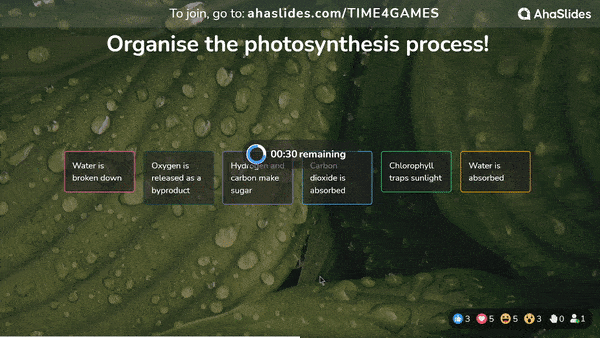
4 長劇
這四種技巧需要長時間練習。它們只是對你的教學方法進行一些小的調整,需要 是時候了解和設置了.
不過,一旦你把它們放進儲物櫃,它們就可以成為課堂上最吸引人的技巧之一。
#5 – 讓他們教
課堂脫離的悲劇之一是 85% 的學校作業 過於死板,無法提高思維能力。 這一點,儘管考慮得比限制性的教學大綱更好,但往往是讓課程引人入勝的原因。
這對於一個老師來說是很難克服的,但是給學生 部分科目的教學責任 是一種絕妙的補救措施。

循環回到你自己的教師培訓。 您是在有關行為管理的教科書練習中更投入,還是在觀察到的實踐中面對大量年輕面孔時更投入? 你在什麼時候在更高的層次上思考和操作?
以下是將學生轉變為教師的一些技巧:
- 循序漸進。 這是一種「長線練習」策略,旨在提升學生的課堂參與度,這是有原因的。學生需要時間和練習來教導任何東西,即使是小組教學。請在全年中安排好練習時間。
- 保持定時。 給他們一個簡短的時間段來教導,以免他們不知所措。 教學時,請留意時鐘,讓他們了解時間是教學的關鍵因素。
- 提高你的期望。 學生往往能夠 方法 比我們給予他們的信任更多。 給他們一個挑戰,看著他們迎接挑戰。
#6 - 混合你的風格
許多學習風格的方法是教師培訓的基礎。 當然,我們了解他們,但儘管我們可能認為我們呼籲 視覺, 聽覺 動覺 學習者,我們很可能至少辜負了一個核心學生群體。
如果你是動覺型學習者,你需要的不只是每週進行一次簡單的實作活動。聽覺型學習者每學期需要的不僅僅是兩次以上的討論。他們需要 持續刺激 繼續上課。

每節課都要確保 每種學習方式至少有一項活動。這些可能是…
- 闡釋概念、做筆記、看影片、玩測驗—— (視覺的)
- 聽Podcast、討論、朗讀、創作音樂—— (聽覺)
- 做實驗、創造實體物品、角色扮演、在教室裡走動—— (動覺)
記住,這可能需要付出很多努力,但絕對值得。隨著課程內容越來越豐富,學生的學習熱情也會越來越高。
專家提示 👊 定義每位學生的學習風格 這25個問題.
7. 使其相關
當我在越南教英語時,我注意到所有教科書都專門引用了英國或美國文化。 根據 全國英語教師委員會 (NCTE),他們更有可能不聽,因為我的越南學生在課程中發現與他們的文化無關。
問題不僅僅在於文化。如果你的課程裡沒有任何內容能讓學生產生共鳴,那他們又何必費心學習這個主題呢?
尤其是對於十幾歲的學生來說,將您的主題與與他們的興趣相關的事物聯繫起來或多或少是必不可少的。
發現這些興趣可以通過 簡單調查. 上世紀 90 年代,康涅狄格州 跑了一個叫做 Interest-a-Lyzer 在公立學校,這太冗長太遠了 90s 供現代使用,但它提出的問題可用於您的調查。 (這也有一個很好的寫作練習的好處!)
一旦你得到了學生的答复,你就可以根據他們的興趣來設計解釋和練習。
#8 – 給他們一個選擇
對於年齡較大的學生,所有活動都需要具備兩點:相關性(我們剛剛討論過)和選擇。
在您的學生在世界上找到自己的方式的時代,t他的選擇就是一切. 教育很少是學習者的選擇問題,但在課堂上給他們選擇可以極大地提高學生的積極性。
以下是將選擇融入課堂的幾種方法:
- 活動 – 提供一堆活動作為練習,然後讓學生選擇。
- 結構體 – 列出課程架構並讓他們選擇如何進行。
- 裝潢 – 讓他們對教室的佈置有發言權。
最好慢慢地把選擇權引入課堂。大多數學生在學校,甚至在生活中,都缺乏選擇,以至於他們常常不確定在課堂上如何選擇。
想要了解更多? 💡 退房 這個優秀的帳戶 教師如何通過提供選擇來提高學生的注意力。
4 在線學習
在線學習正變得越來越普遍,但保持學生遠距離學習的積極性似乎越來越難。
這裡有 4 個小貼士,讓你嘗試不同的東西 遠程教室,或者你可以 在這裡多買一堆!
9.擁抱科技
2020年,幾乎所有課程都轉移到線上,教師們自然傾向於堅持他們熟悉的線下教學方法。這種做法在早期階段行得通,但現在行不通了。
豐富的教育、創意和協作工具徹底改變了虛擬教室。 有很多方法可以做老師和學生在冠狀病毒爆發之初都做夢也想不到的事情。

這裡有幾個 教師和學生可以在在線課程中使用的工具:
- 了解內容 X 📊
互動式簡報製作工具,讓學生主持主題並創建 現場投票, 在線測驗 並集思廣益。這是 創新的教學方法 在教師的社交圈裡流傳著這樣的話題。 - 色雀 ????
一款簡單但功能強大的照片編輯和圖形設計軟件。 Colorcinch 擁有大量矢量圖形、庫存照片和特效。 - Canva 🖌️
一種創建圖像、海報、小冊子、小冊子等的簡單方法。Canva 有一個龐大的模板庫和預製元素可供構建。 - 米羅 🗒️
學生可以用來進行頭腦風暴的公共白板可以同時說明思維過程和設計解決方案。 - 翻轉網格 📹
一個視頻平台,教師可以在其中提出問題並接收學生的視頻回复。
一定年齡層的學生對科技有著天生的好奇心,因此擁抱科技是提升學習參與度的完美策略。然而,要注意不要過度——一次性使用太多新工具可能會分散學生的注意力。
#10 – 翻轉劇本
“翻轉學習” 指的是學生在家學習概念,然後利用課堂時間積極討論和解決與所學概念相關的問題。你可以把它想像成通常的學校作業和家庭作業的關係,只是…顛倒了。
在遠程教育世界中,學校作業和家庭作業在同一張桌子上完成,翻轉學習更多的是交換同步工作(有現場老師)和異步工作(沒有現場老師)的角色。
大量證據表明,遠距教育將迎來一場翻轉學習革命。其中最令人鼓舞的數據來自 翻轉學習網絡的一項調查 – 80% 嘗試過這種方法的教師表示 提高學生的積極性.
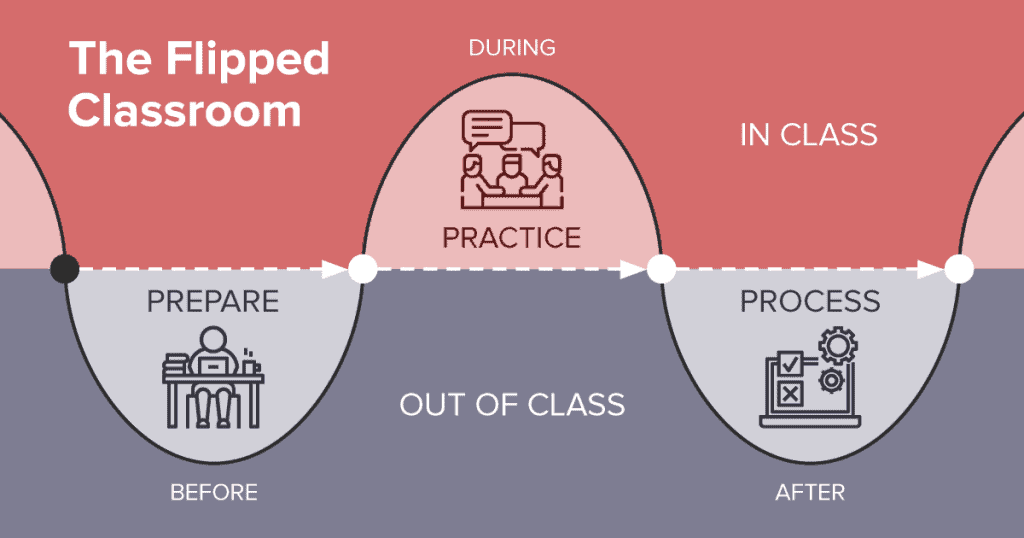
理由何在? 查看翻轉學習對增加學生參與的一些好處:
- 在課堂上,學生可以參與 按照他們自己的節奏. 能力較低和較高的學生可以專注於適合他們的任務。
- 更多 自治 而學生對學習擁有自主權,這是一個巨大的激勵因素。
- 翻轉學習讓學生 做某事 而不是將他們視為被動的信息獲取者。 這使您的課程與整個上學日的其他標準課程區分開來,並鼓勵學生參與其中。
想嘗試嗎?在你的下一個線上課程中嘗試這個:
- 上課前: 為學生創建一個共享的主題材料文件夾(視頻、播客、錄音講座、閱讀資源等),並告訴他們學習每個材料。
- 在課程開始時: 給學生一個快速測驗來衡量他們對主題的理解,然後根據每個學生的理解水平將他們分組。
- 上課期間: 向每個小組展示刺激性的活動(討論、合作、解決問題)以鞏固理解。
想閱讀更多? 💡 看看這個 翻轉學習的精彩介紹 萊斯利大學
#11 – 參觀畫廊
如果你知道自己的作品會被同行看到,你會更有動力嗎?很可能動力十足。這就是畫廊漫步的理念。
畫廊漫步是一種幻燈片式的展覽,學生的作品會互相展示。在觀看作品的過程中,學生會進行觀察,並記錄下自己的感受。
這就是為什麼它是一項如此出色的學生課堂參與活動:
- 它增加 學生動機 通過他們與生俱來的競爭意識。
- 它增加 學生焦點 因為他們從同齡人而不是與他們無關的人那裡觀看作品。
- 它增加 學生自由 表達,這總是積極的動機。
就您而言,畫廊漫步的設置非常簡單。 只需創建一個演示文稿,並留出空間記錄評論,如下所示。
#12 – 永遠不要放棄小組工作
在向遠程學習的大遷移中,所有被淘汰的學習形式中,最大的犧牲品是團隊合作。
在學生需要的時候 社交互動與合作 最糟糕的是,許多老師認為將小組作業轉移到網路世界是一項不可能的任務。學生們在大部分「學習」時間裡都感到與同學完全隔絕。
這會嚴重影響學習者的積極性. 這裡有一些小組工作技巧來對抗它:
- 讓他們訪問文件共享軟件,例如 Google 雲端硬盤。
- 讓他們訪問看板(任務分配)軟件,例如 Trello。
- 使用 Zoom 和其他視訊通話軟體上的「分組討論室」來模擬現實世界的小組工作。
- 將大項目分解成多個小任務,分組完成。
常見問題(FAQ)
您如何衡量學生在課堂上的參與度?
有許多方法可以定量和定性地衡量學生在課堂上的參與度,例如:
– 觀察量表 – 教師客觀地記錄任務行為,如積極參與、眼神接觸、依照規定時間間隔提出的問題。
– 任務時間 – 追蹤學生積極參與教學活動與非任務時間的總時間百分比。
– 學生自我報告 – 調查透過注意力、價值、課程享受度等問題來衡量感知到的認知、行為和情感參與。
– 家庭作業/任務 – 評估獨立工作的品質和完成可以深入了解個人參與。
– 參與日誌 – 記錄舉手次數、參與討論的次數等。
– 考試分數/成績 – 學業成績與參與度相關,但並非完全由參與度決定。
– 教師評分量表 – 問卷調查讓教師對課堂/學生的參與度進行定性評分。
– 非正式檢查 – 例如對鷹架問題的回答以及任務對話主題。
課堂參與有什麼好處?
更投入的學生會表現出更好的考試成績、專案品質和學習記憶力。引人入勝的課程讓學習變得更加有趣,並賦予學生主人翁意識,激發內在動力。


